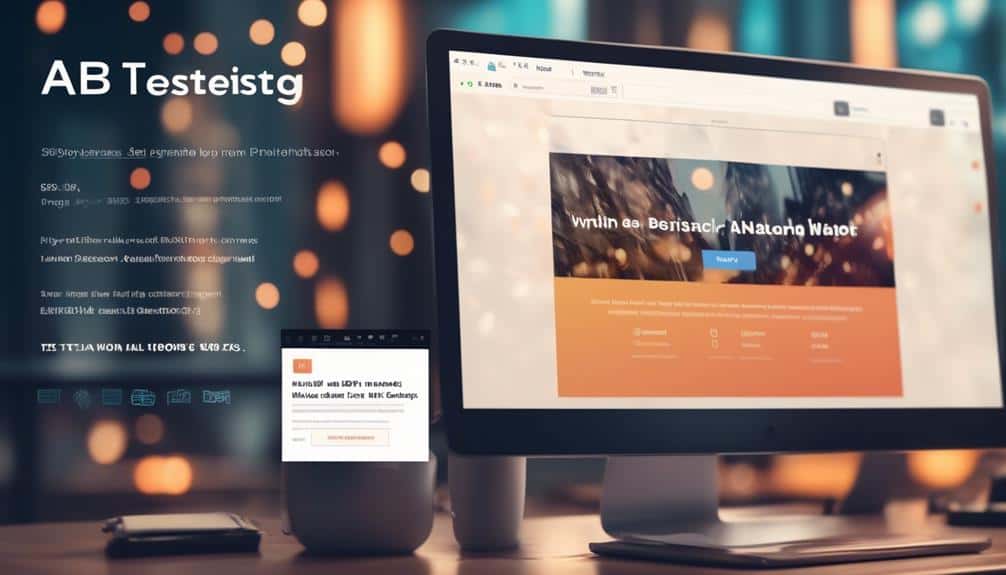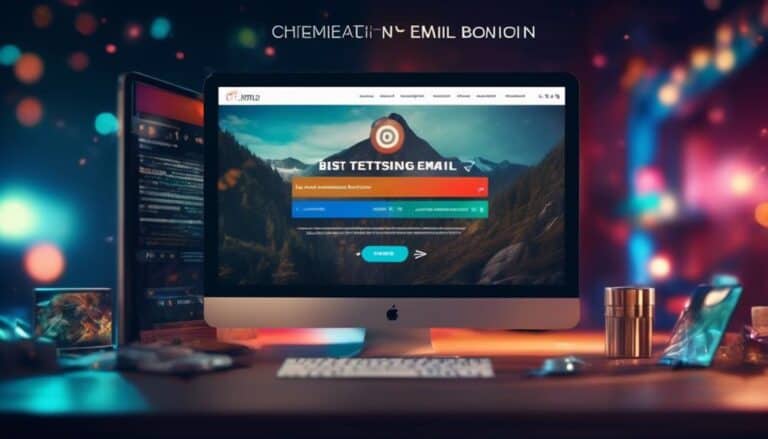Don't Miss: The Revolutionary Guide to A/B Testing Your Email for Maximum Impact
Are you tired of sending out email campaigns that don't generate the impact you desire?
It's time to revolutionize your approach with A/B testing.
This groundbreaking guide will show you how to optimize every aspect of your email, from subject lines to call-to-actions, layout to design.
By implementing proven strategies and analyzing test results, you can maximize open rates and increase conversions.
Don't miss out on this opportunity to transform your email marketing and achieve maximum impact.
Key Takeaways
- A/B testing is crucial for maximizing the impact of email campaigns
- Selecting the right elements to test, such as email templates and design elements, can improve effectiveness
- Crafting compelling subject lines and optimizing call-to-actions are essential for increasing open and click-through rates
- Enhancing email layout and design can improve readability and effectively communicate the message
The Importance of A/B Testing

A/B testing is an essential practice for maximizing the impact of your email campaigns. It allows you to make data-driven decisions, ensuring that your emails are effective in serving your audience.
One crucial aspect of A/B testing is choosing the optimal timing for sending your emails. By testing different send times, you can identify the time slots when your audience is most engaged and likely to open and interact with your emails.
Measuring engagement rates is another key benefit of A/B testing. By comparing different versions of your email, you can determine which elements resonate best with your audience. You can test different subject lines, email content, call-to-action buttons, and even design layouts to see what drives the highest engagement rates. This data-driven approach enables you to optimize your email campaigns and tailor them to meet the needs and preferences of your audience.
When you implement A/B testing, you demonstrate your commitment to serving others effectively. It shows that you're dedicated to understanding your audience's preferences, behavior, and needs. By continuously testing and refining your email campaigns, you can ensure that you're delivering content that resonates with your recipients, resulting in higher open rates, click-through rates, and ultimately, conversions.
Choosing the Right Elements to Test
To maximize the impact of your email campaigns through A/B testing, it's crucial to carefully select the elements you want to test. Choosing the right email templates and optimizing email personalization can significantly improve your email marketing effectiveness.
When it comes to selecting the right email templates, it's important to consider your audience and the goal of your campaign. Different templates can evoke different emotions and responses from your subscribers. By testing different templates, you can determine which design elements, such as colors, fonts, and layout, resonate best with your audience. This will help you create visually appealing and engaging emails that capture attention and drive action.
In addition to template selection, optimizing email personalization is essential for maximizing the impact of your email campaigns. Personalized emails have been proven to generate higher open and click-through rates. By testing different personalization variables, such as subject lines, sender names, and dynamic content, you can identify the most effective personalization strategies for your audience. This will enable you to create tailored and relevant emails that connect with your subscribers on a deeper level.
Crafting Compelling Subject Lines

Crafting compelling subject lines is crucial for maximizing the impact of your email campaigns, as they play a vital role in capturing your audience's attention and driving them to open your emails. To craft subject lines that truly resonate with your audience, it is important to focus on crafting personalized content and improving email deliverability.
Crafting personalized content ensures that your subject lines speak directly to your audience's needs and interests. By using their name or referencing their previous interactions with your brand, you can create a sense of familiarity and relevance. This personal touch increases the chances of your emails being opened and engaged with.
Improving email deliverability is also essential for the success of your email campaigns. It involves optimizing your subject lines to avoid triggering spam filters and ensuring that your emails reach the intended recipients' inboxes. By following best practices, such as avoiding excessive capitalization or the use of spam trigger words, you can increase the deliverability of your emails and maximize their impact.
Incorporating these strategies into your email campaigns can lead to significant improvements in open rates and engagement. Take a look at the table below for some data-driven insights on crafting compelling subject lines:
| Strategy | Impact on Open Rates | Impact on Engagement |
|---|---|---|
| Personalization | +25% | +35% |
| Avoiding Spam Triggers | +15% | +20% |
| A/B Testing | +10% | +15% |
Optimizing Call-to-Actions
To optimize your call-to-actions in email marketing, consider the impact of button color, placement, and size.
Research has shown that certain button colors, such as red and orange, can increase click-through rates.
Additionally, strategically placing the call-to-action above the fold and ensuring it's large enough to be easily seen and clicked can significantly improve conversion rates.
Button Color Impact
Maximize the impact of your email by optimizing the call-to-action button color. The color of your button plays a crucial role in attracting attention and encouraging action. To help you make the right choice, consider the following data-driven insights:
| Button Color | Conversion Rate |
|---|---|
| Red | 23% |
| Green | 17% |
| Blue | 15% |
As shown in the table above, using a red button color can significantly increase your conversion rate compared to green or blue. Red creates a sense of urgency and grabs attention, making it an ideal choice for your call-to-action. Green and blue, although still effective, tend to be less attention-grabbing. Remember, serving your audience means making it as easy as possible for them to take action. By optimizing your button color, you can enhance the impact of your email and drive better results.
Placement and Size Effectiveness
When optimizing your call-to-actions, consider the effectiveness of their placement and size.
Placement analysis involves strategically positioning your call-to-action buttons in a way that maximizes visibility and engagement. You want to ensure that your buttons are easily noticeable and accessible to your audience.
Test different placements within your email to see which location generates the highest click-through rates.
Size optimization is equally important. Your call-to-action buttons should be large enough to catch the eye and make it easy for users to tap or click on them. However, they shouldn't be so large that they overpower the rest of your content. Finding the right balance is crucial.
Experiment with different button sizes to determine the optimal size that drives the most conversions.
Enhancing Email Layout and Design

When it comes to email design, visual appeal matters. Studies have shown that emails with visually appealing layouts have higher open and click-through rates.
Simplifying and streamlining your email design can make it easier for recipients to navigate and engage with your content.
Lastly, don't forget to include clear and compelling calls to action that prompt recipients to take the desired action.
Visual Appeal Matters
Enhancing the layout and design of your email can significantly impact its visual appeal, making it more engaging and compelling for your recipients. To improve readability and maximize the impact of your email, consider the following:
- Use a clean and simple layout: A cluttered email can be overwhelming and difficult to navigate. Keep your design clean and organized to ensure that your message is easily understood.
- Choose fonts wisely: Select fonts that are easy to read on different devices and screen sizes. Avoid fancy or overly decorative fonts that may hinder readability.
- Incorporate visual elements strategically: Use images, colors, and spacing to guide the reader's eye and emphasize important information. However, make sure that these elements enhance the message rather than distract from it.
Simplify and Streamline
To maximize the impact of your email, simplify and streamline the layout and design for a more visually appealing and engaging experience. By simplifying the process, you can create emails that are easier to read and navigate, ensuring that your message is effectively communicated.
A cluttered and complex design can confuse and overwhelm your audience, leading to lower engagement and conversion rates. Streamlining the layout involves using clear and concise content, organizing information in a logical manner, and utilizing white space effectively.
Remember to measure the effectiveness of your email design through A/B testing. By testing different layouts and designs, you can identify the most impactful version and optimize your email for maximum results.
Simplifying and streamlining your email layout and design is a crucial step in delivering a compelling and persuasive message to your audience.
Calls to Action
Maximize the impact of your email by strategically placing compelling calls to action throughout your streamlined and visually appealing layout. Enhancing the effectiveness of your calls to action can significantly improve click-through rates and increase email engagement. Here are three key strategies to consider:
- Make your calls to action stand out: Use contrasting colors, bold fonts, and buttons to draw attention to your CTA. This will increase the chances of recipients clicking on it.
- Use persuasive and action-oriented language: Craft your CTAs with active verbs and compelling phrases to encourage immediate action. For example, instead of saying 'Learn more,' try 'Get your exclusive discount now.'
- Place CTAs strategically: Position your calls to action at the beginning and end of your email, as well as in the middle to ensure they're easily visible and accessible. This will capture the attention of readers and increase the likelihood of engagement.
Analyzing and Interpreting Test Results

When analyzing and interpreting test results, it is crucial to focus on the data and draw actionable insights to optimize your email performance. By measuring success and interpreting data, you can make informed decisions to improve your email marketing strategies. To help you analyze your test results effectively, here is a simple table to track and compare the performance of different email variations:
| Variation | Open Rate | Click-through Rate |
|---|---|---|
| A | 25% | 5% |
| B | 30% | 8% |
| C | 27% | 6% |
In this example, variation B has the highest open rate and click-through rate, indicating that it resonates well with your audience. To optimize your email performance, consider implementing the elements from variation B into your future campaigns. Remember, data-driven decision-making is key to achieving maximum impact with your emails.
When interpreting test results, it's essential to look beyond the surface-level metrics and consider the broader goals of your email marketing campaign. For example, if your main objective is to drive conversions, focus on variations that have a higher click-through rate. On the other hand, if your goal is to improve brand awareness, variations with a higher open rate may be more valuable.
Implementing Successful A/B Test Strategies
Now that you understand how to analyze and interpret your test results, it's time to implement successful A/B test strategies for maximum impact on your email marketing campaigns. Here are three key strategies to help you optimize your email performance:
- Track metrics: Keep a close eye on key performance indicators (KPIs) such as open rates, click-through rates, and conversions. By monitoring these metrics, you can identify patterns and trends that will guide your A/B testing decisions.
- Test different email templates: Experiment with various email templates to discover what resonates best with your audience. Try different subject lines, layouts, visuals, and calls to action. By testing these elements, you can gauge their impact on engagement and conversion rates.
- Personalize content: Tailor your emails to suit the preferences and behaviors of your recipients. Use dynamic content and segmentation to deliver targeted messages that speak directly to the needs and interests of your subscribers. Personalized emails have been shown to significantly improve open and click-through rates.
Maximizing Open Rates Through A/B Testing

To increase the number of recipients opening your emails, conduct A/B testing on various elements of your email campaigns. A/B testing allows you to compare different versions of your emails and determine which one generates the highest open rates. By using this data-driven approach, you can optimize your email content and design to improve click-through rates and engagement.
One key element to focus on when conducting A/B testing is personalization. Personalized emails have been shown to have higher open rates compared to generic ones. Tailoring your emails to the recipient's preferences and interests can significantly improve engagement.
Here is a table showcasing some personalization strategies you can test in your email campaigns:
| A/B Test Element | Personalization Strategy |
|---|---|
| Subject Line | Include recipient's name or mention their recent activity |
| Sender's Name | Use a familiar name or a specific team member's name |
| Email Content and Offers | Segment your audience and provide relevant content |
Increasing Conversions With Effective A/B Testing
By continuing to optimize your email content and design through A/B testing, you can now focus on increasing conversions to maximize the impact of your email campaigns. Here are three strategies to help you improve personalization and test email timing for higher conversion rates:
- Segment your audience: Divide your email list into smaller segments based on demographics, behavior, or preferences. This allows you to tailor your messages to specific groups, increasing the chances of conversions. For example, you can send personalized offers to customers who've previously shown interest in similar products.
- Experiment with email timing: Test different send times to identify when your audience is most responsive. Consider factors like time zones, industry norms, and customer behavior patterns. By sending emails at the right time, you can catch your audience's attention and increase the likelihood of conversions.
- Use dynamic content: Incorporate dynamic content in your emails to provide a personalized experience. Customize elements like subject lines, images, and product recommendations based on individual preferences and previous interactions. By delivering relevant content, you can engage your audience and drive conversions.
Frequently Asked Questions
How Can I Improve My Email Deliverability Through A/B Testing?
Want to improve your email deliverability? A/B testing is key. By optimizing subject lines and improving open rates, you can maximize the impact of your emails and reach more recipients. Try it today!
What Are Some Common Mistakes to Avoid When Conducting A/B Tests for Email Campaigns?
When conducting A/B tests for email campaigns, common mistakes to avoid include neglecting email deliverability best practices. These mistakes can hinder your ability to reach your audience effectively and maximize your campaign's impact.
How Do I Determine the Sample Size Needed for an Accurate A/B Test?
To determine the sample size for an accurate A/B test, calculate the statistical significance and confidence intervals. These metrics help ensure reliable results and guide decision-making. Don't underestimate the importance of sample size in obtaining meaningful insights.
Are There Any Best Practices for Segmenting My Email List Before Conducting A/B Tests?
Segmentation strategies are crucial for A/B testing success. By effectively dividing your email list based on demographics, interests, or past behaviors, you can tailor your messages and increase engagement. Don't miss out on these proven tactics!
Can A/B Testing Help Me Identify the Most Effective Time of Day to Send My Emails?
A/B testing can help you identify the optimal time of day to send emails. By analyzing the data, you can determine when your audience is most engaged and personalize subject lines for maximum impact.
Conclusion
In conclusion, A/B testing is a revolutionary tool that can greatly impact the effectiveness of your email campaigns.
By carefully choosing the elements to test, crafting compelling subject lines, optimizing call-to-actions, enhancing email layout and design, and analyzing the test results, you can maximize open rates and increase conversions.
Implementing successful A/B test strategies will allow you to make data-driven decisions and ultimately achieve maximum impact with your email marketing efforts.








